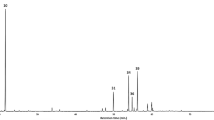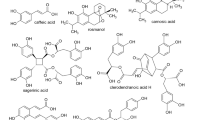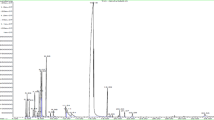Abstract
THE isolation of a number of polymethylanthracenes from fractions of a Kuwait crude oil has been reported by one of us1. The hydrocarbons were obtained by treatment of acetone extracts of the oil with maleic anhydride and chromatography of the material recovered from the acidic adducts by distillation from sodium hydroxide. We have now applied the same procedure to higher-boiling fractions of acetone and furfural extracts of the Kuwait oil (corrected boiling points in the range 390–440° C.) and have obtained crystalline fractions consisting essentially of alkyl derivatives of 1,2-benzanthracene. This is evident from their ultra-violet absorption spectra, which closely resemble those of typical alkylbenzanthracenes2. Vapour-phase chromatography of some of the fractions indicates, however, that they are mixtures containing varying proportions of benzanthracene and other components with retention times similar to those of mono- and dimethylbenzanthracenes. 1,2-Benzanthracene itself was isolated from several fractions by further chromatography on alumina as colourless plates, m.p. 154–156° undepressed, when mixed with an authentic specimen, m.p. 158–159°. The ultra-violet spectrum of the isolated material (λmax. 228, 256, 267, 277, 287; 299, 314, 327, 342, 358; 374, 384 mµ; log ɛ, 4.54, 4.51, 4.64, 4.89, 4.98; 3.95, 3.70, 3.80, 3.85, 3.69; 2.69, 2.86), and the infra-red spectrum3, were identical with those of 1,2-benzanthracene, and vapour-phase chromatography gave one peak with retention time similar to that of benzanthracene under the same conditions. The 2,4,7-trinitrofluorenone addition complex formed red needles, m.p. 217–221°, not depressed when mixed with an authentic specimen, m.p. 220–223° 4, and the identification was confirmed by preparation of the s-trinitrobenzene complex, orange needles, m.p. 161–163°, and comparison of this with an authentic specimen, m.p. 162–163° (found: C, 65.3; H, 3.6; C24H15N3O6 requires C, 65.3; H, 3.4 per cent).
This is a preview of subscription content, access via your institution
Access options
Subscribe to this journal
Receive 51 print issues and online access
$199.00 per year
only $3.90 per issue
Buy this article
- Purchase on Springer Link
- Instant access to full article PDF
Prices may be subject to local taxes which are calculated during checkout
Similar content being viewed by others
References
Carruthers, W., J. Chem. Soc., 603 (1956).
Jones, R. N., J. Amer. Chem. Soc., 62, 148 (1940). Badger, G. M., Pearce, R. S., and Pettit, R., J. Chem. Soc., 1112 (1952).
cf. Fuson, N., and Josien, M.-L., J. Amer. Chem. Soc., 78, 3049 (1956).
Orchin, M., and Woolfolk, E. O., J. Amer. Chem. Soc., 68, 1727 (1946).
Newman, M. S., and Otsuka, S., J. Org. Chem., 23, 797 (1958).
Takemura, K. H., Cameron, M. D., and Newman, M. S., J. Amer. Chem. Soc., 75, 3280 (1953).
Hieger, I., and Woodhouse, D. L., Brit. J. Cancer, 6, 293 (1952).
Hartwell, J. L., Survey of Compounds which have been Tested for Carcinogenic Activity, second ed. (United States Government Printing Office, Washington, 1951). Shubik, P., and Hartwell, J. L., Supp. 1 to the Survey (1957).
Hadler, H. I., Darchun, V., and Lee, K., J. Nat. Cancer Inst., 23, 1383 (1959).
Steiner, P. E., and Edgcombe, J. H., Cancer Res., 12, 657 (1952).
Badger, G. M., et al., Proc. Roy. Soc., 129, 439 (1940).
Bachman, W. E., and Clarke, H. T., J. Amer. Chem. Soc., 49, 2089 (1927).
Clar, E., and Lombardi, L., Ber., 65, 1411 (1932).
Jones, R. C., and Neuworth, M. B., J. Amer. Chem. Soc., 66, 1497 (1944).
Dietz, W. A., Dudenbostal, B. F., and Priestley, W., Amer. Chem. Soc., Div. Petrol. Chem. Preprints 1, No. 4, Polycyclic Hydrocarbons. 117 (1956).
Lijinsky, A., Raha, C. R., and Keeling, J., Anal. Chem., 810 (1961).
Author information
Authors and Affiliations
Rights and permissions
About this article
Cite this article
CARRUTHERS, W., DOUGLAS, A. 1,2-Benzanthracene Derivatives in a Kuwait Mineral Oil. Nature 192, 256–257 (1961). https://doi.org/10.1038/192256a0
Issue Date:
DOI: https://doi.org/10.1038/192256a0
This article is cited by
-
Polycyclic aromatic compounds of environmental and occupational importance
Fresenius' Zeitschrift für analytische Chemie (1986)
-
Method of separating sulfur compounds and aromatic hydrocarbons from high-boiling fractions of sour crudes
Chemistry and Technology of Fuels and Oils (1974)
-
1,2-Benzanthracene Derivatives in a Kuwait Mineral Oil
Nature (1967)
-
The hydrocarbon constituents of petroleum and some possible lipid precursors
Journal of the American Oil Chemists' Society (1967)
Comments
By submitting a comment you agree to abide by our Terms and Community Guidelines. If you find something abusive or that does not comply with our terms or guidelines please flag it as inappropriate.



